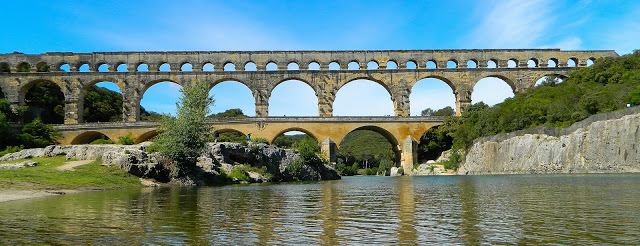Heading north and west from the Rhone in Languedoc-Roussillon, we found with unexpected trip luck a vintner’s aire at Uzès.
This utterly beguiling stone built medieval town was built upon a Roman settlement linked to the astonishing architectural gem of the Pont du Gard, a little further west. To view the bridge we cycled from a busy free overnight stop at the pretty waterside town of Remoulins – and would return to Uzès.

The bridge and three-tiered aqueduct was a breath-taking sight bestriding the currently low waters of the wide river Gard.
We wandered behind to see the more obviously weather-beaten northern side and the engineering of the beams and constructions used 2000 years ago, to carry fresh water from a spring in Uzès to the prosperous Roman city of Nimes.

The bridge is decorated with graffiti from the18th century and later. Presumably there were earlier recorded declarations of love (and defamation) carved into the soft sandstone but they were eroded with time. It was both spectacular, and theatrical.

Uzès quickly won our hearts, its 17th century elegant boulevards endow a medieval and Roman heritage which somehow despite the damaging wars of religion that decimated the South of France under Cardinal Richelieu, has survived.
Its high limestone walled castle keep and villas shelter a winding market town of covered walkways, public squares and private alley ways.

Its stone-ribbed cathedral is a witness to the turmoil of the region’s religious past. Completed in 1090 it was destroyed in the first crusade against the Cathars, to be rebuilt as a Protestant temple and later destroyed in the Religious Wars.
Today it is a quietly impressive and peaceful space in the bustling heart of the old town.

We stayed for three days enjoying cycling the local area full of vines, poppies and chickpeas – it was harvest and celebration time of the ‘pois-chiches’.
Fortified villages tumbled up and down the hillsides and we admired public bread ovens, covered wells, simple churches and crumbling graveyards.

Every garden and allotment was pristine and many village houses had carefully tended roses and wisteria growing around their brightly painted shutters.
Although so windy – it was hard to stay on the bikes at times – the views across to the Cevennes foothills were stunning.

We enjoyed spending a day’s budget on local food at Uzès’ Saturday market of gourmet and farm producers and in the evenings we returned to enjoy café life under the leafy plane trees and watch the townspeople go by.
Saturday brought the annual fete at the vineyard hosted by brothers Didier and Robert. We were invited to join the trestle tables of picnicking families and friends inside the cavernous cave and small jazz four-piece played sentimental French songs as well as some swing classics which we all danced to!









